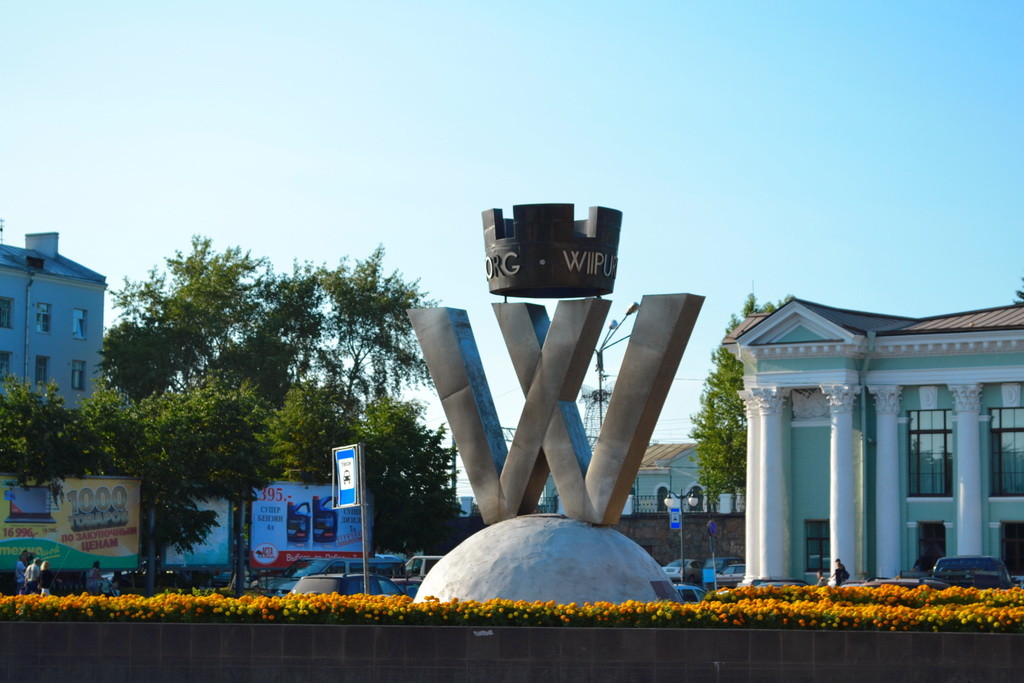We should have written: Vyborg is full of history. But it would not be the truth. Vyborg is history.
It’s just 122 km away from St. Petersburg and is easily reached by car, bus or train within a two-hour journey. An express train will get you there for less that 1,5 hour.
A town of nearly 80,000 was founded by Swedish knights in 1293 and served as a outpost of the Swedish kingdom that was run the region. The Novgorod republic repeatedly tried to challenge the Swedish dominance, but failed. Vyborg was responsible for the control of the territory and trade relations with Tallinn and Novgorod. Over the course of history, the town was run by Swedish, Finnish and Russians which affected its architecture and the practicalities of life. A final handover of Vyborg to Russia happened just in 1944, so the Soviets had rather limited time to turn the town into a purely Soviet settlement (if such an aim was ever set). That’s why we call it a European town, not a European-like as is case with St. Petersburg, but namely a European one. To some degree, it’s kind of something anti-Russian in terms of architecture and the structure of streets.
More detailed Vyborg’s history can be found here.
Railway station and the Vyborg’s emblem. Will you guess how the locals jokingly call the emblem? Of course, Volkswagen.
Salakka-Lahti creek. Walking along its shore from the station is the easiest way to get to the town’s center and the Vyborg castle, the main attraction.
Druzhba (Friendship) is the biggest Vyborg’s hotel, located on the Salakka-Lahti’s shores. There are two viking drakkars (dragonships) just opposite the building.
A marketplace is a feature of every medieval town. Vyborg is, of course, no exception here.
This building so far hosts a market where you can buy food and souvenirs.
This Northern modern building used to be the Bank of Finland’s Vyborg branch. Vyborg has plenty of Northern modern.
The Round Tower is a stone artillery tower, one of the two Vyborg medieval towers survived up to our days. It was built in 1547 – 1550, and now hosts The Round Tower restaurant.
The streets of Vyborg go up and down. Time seems to have stood still in the town.
Many Vyborg streets are cobblestone which is very untypical for Russia.
The main attraction of the town is the Vyborg castle founded by a Swedish Marshall Torgils Knutsson in 1293 during the third Swedish crusade against the Karelians. This is the only medieval castle in Russia, now it’s a big museum with exhibitions souvenir shops and entertainments inside. The best experience you can have there is a 360-degree view of the town from the St. Olaf tower’s viewpoint.
The castle hosts a lot of shows and festivals like Serenades of the Vyborg castle (jazz), May tree (folk), many of them Middle Ages-themed, of course.
During the May tree festival people dressed in medieval costumes gather in the castle and around. Knight tournaments, archer contests and other competitions are held. The central event is a concert featuring folk and folk-rock.
The Vyborg fortress is located on the Castle island and, naturally, surrounded by water.
Entrance to the Vyborg fortress
The fortress courtyard
Walking along this pave gets us to the castle where we watch exhibitions and go upstairs to the St. Olaf tower’s viewpoint.
For just 100 rubles (about $1,5) you can test your archery skills or buy a medieval indulgence with almost real seal.
You also can have your photo with knights or even get dressed as a knight.
The altitude of the St. Olaf tower is 48.6 m. These windows used to serve for shooting at enemies trying to seize the fortress.
The St. Olaf tower is the castle’s tallest and oldest structure. From 38 meters we enjoy ourselves with the Vyborg and suburbs overview capturing up to 30 km. A view of the downtown.
Look at the same picture in the winter to feel the contrast.
The Petrovsky bridge and Salakka Lahti view
The Port of Vyborg and South haven view
The fortress courtyard
The castle exhibitions feature the Vyborg and castle history as well as the region’s flora and fauna.
Exhibits of the castle museum
A monument to the Vyborg founder’s Torgils Knutsson, located on the Town hall square just opposite the castle. The Town hall is behind the monument.
The Clock tower is an architecture centerpiece, the former Vyborg Cathedral’s bell tower destroyed during the Soviet-Finnish war.
Café Sova and Camelot restaurant (opposite). These eateries can be recommended for their delicious dishes, we visited them regularly.
A nice restored house with little towers.
A Northern modern house built by Carl Eduard Dippell, a Vyborg architect of German origin, in 1898.
Originally a headquarter of a trade company, it is one of the Vyborg’s most prominent centerpieces of the Northern modern.
Preobrazhensky Cathedral (Orthodox), located on the Cathedral square, regarded as one of the most prominent examples of the classicism. Founded by Katherine the Great.
The Peter and Paul church is the only Lutheran temple in Vyborg survived, founded on August 6, 1793.
Like Moscow, Vyborg has its Red square with, of course, a monument to the world communist movement leader Vladimir Lenin.
We have not covered some other attractions like a landscape park of Mon Repos, a place visited by local and St. Petersburg residents on weekends. One of the great things about Vyborg is that it is an attraction itself superbly fit for a day-trip from St. Petersburg.
The best option is to come here in the morning or about at the midday and spend the whole day till an evening train or a bus to return to the city. And don`t forget to read our post How to get to Vyborg from St Petersburg.
